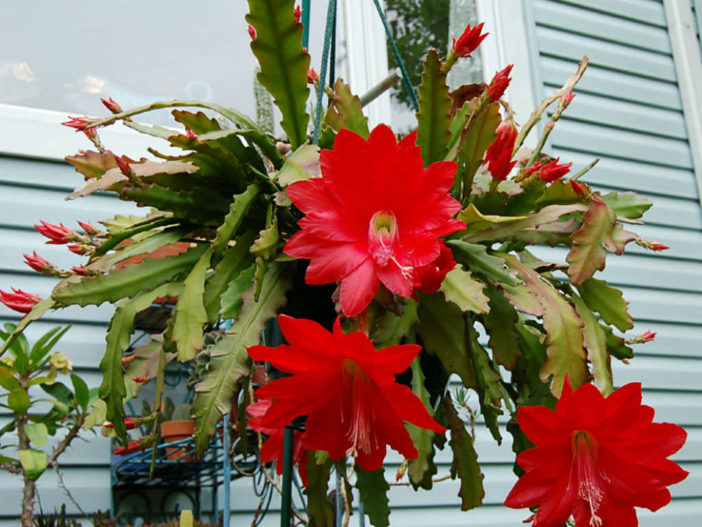Scientific Name
Disocactus ackermannii (Haw.) Ralf Bauer
Common Name(s)
Red Orchid Cactus, Orchid Cactus, Strap Cactus
Synonym(s)
Cactus ackermannii, Disocactus ackermannii subsp. ackermannii, Epiphyllum ackermannii, Heliocereus ackermannii, Nopalxochia ackermannii, Phyllocactus ackermannii, Weberocereus ackermannii
Scientific Classification
Family: Cactaceae
Subfamily: Cactoideae
Tribe: Hylocereeae
Genus: Disocactus
Description
Disocactus ackermannii is an attractive epiphytic cactus with a short cylindrical main stem and longer leaf-like portions with wavy edges. The main stem is up to 7 inches (17.5 cm) long. Flattened portions are green or reddish, erect at first, becoming pendant, up to 30 inches (75 cm) long, and up to 3 inches (7.5 cm) wide.
The flowers are funnel-shaped, crimson to scarlet, with a greenish throat. They are up to 5.6 inches (14 cm) in diameter and appear in spring.
In cultivation, Disocactus ackermannii is often confused with Disocactus × hybridus.

Hardiness
USDA hardiness zones 10a to 11b: from 30 °F (−1.1 °C) to 50 °F (+10 °C).
How to Grow and Care
Many of the cultivated plants known as Epiphyllum hybrids are derived from crosses between species of Disocactus (rather than Epiphyllum) and other genera in the Hylocereeae.
Disocactus should be grown in rich but still well-draining soil. They should be watered regularly and fertilized as well. This is essential for good growth and flowering. During the growing period, the plants need frequent watering. The watering should be rather abundant so that the soil becomes completely soaked but let dry between watering. Keep relatively dry in winter or when night temperatures remain below 50 °F (10 °C). During the growing season, fertilize Disocactus once each month with a water-soluble, 10-10-10 fertilizer. Dilute the fertilizer with water, using about one teaspoon of fertilizer per one gallon of water.
These cacti dislike extreme heat and cold, so they are best green-housed during the depth of winter and heat of summer in hot, dry climates. They also prefer shade to sun and a little extra humidity in the air.
Disocactus perform best when they are root bound, meaning their roots fill their container or other growing space. A cactus planted in a 4-inch (10 cm) pot will flower quicker than one in an 8-inch (20 cm) pot. If the cactus has flowered, wait one month after it blooms before repotting it.
Disocactus can be reproduced both by seeds and cuttings.
Learn more at How to Grow and Care for Disocactus.
Origin
Disocactus ackermannii is native to the tropical forests of Veracruz and Oaxaca in Mexico. It is considered to be a natural hybrid between Disocactus phyllanthoides and Heliocereus speciosus.
Links
- Back to genus Disocactus
- Succupedia: Browse succulents by Scientific Name, Common Name, Genus, Family, USDA Hardiness Zone, Origin, or cacti by Genus
Photo Gallery
Click on a photo to see a larger version.

